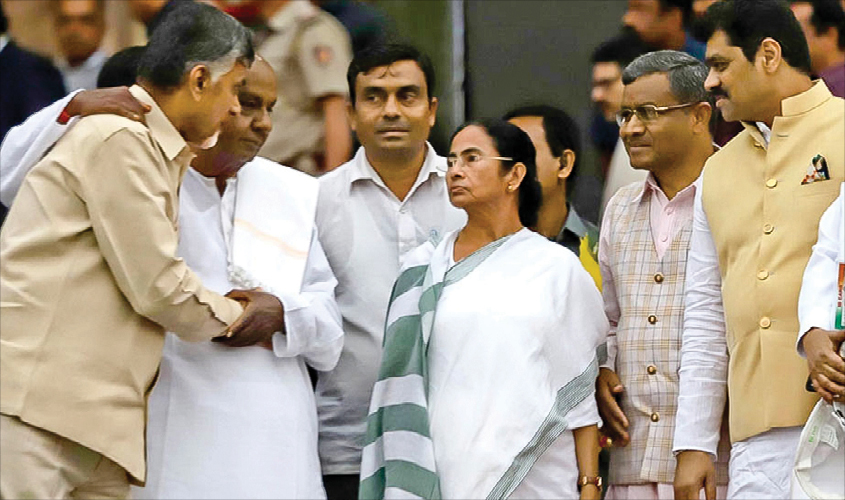The attendance of almost every political leader from across the country, representing primarily regional parties, for the swearing in of the H.D. Kumaraswamy-G. Parameshwara government in Bengaluru was effectively a line-up of star investors in the new partnership of the Congress and the Janata Dal (Secular).
They were there as stakeholders in the JDS-Congress government in Karnataka. The new Chief Minister acknowledged as much; the attendance of so many leaders from around the country “was not to support my government”; it was to signal a “major change in the political situation”. Almost every one of the leaders had worked before and after the elections to snatch an anti-Bharatiya Janata Party victory out of the fractured mandate, and “let the past be history”. The behind-the scenes tutoring had one purpose: “In the interest of the nation, I must ally with the Congress.”
The new beginning was best captured when Mayawati and Sonia Gandhi butted heads and wrapped their arms around each other; Mamata Banerjee joined them but she also separately bonded with the Bahujan Samaj Party leader. These were clues to the cautious process of coalescing of political parties against a dominant political force that has declared its agenda to become the only pan-India party, by gobbling up the opposition at every level of representation—from the municipal-panchayat to the Rajya Sabha.
Numbers put Mamata Banerjee and the Trinamool Congress at the head of the collective; her party has 38 members in Parliament, just behind the Congress. Therefore she can in many ways define the events of the past week as an exercise in the “unity of the regional parties”, on an omnibus agenda of development—of the nation, of the people and of the federal set up. By stating that “we have nothing to do with what the Congress says” and will do what each of them must, “keep in touch with all the regional parties”, Mamata Banerjee has summed up the compulsions of the new league and also of the Congress.
There is a consistency in what Mamata Banerjee has said over the past months. Tactically, the regional parties as well as the Congress and by extension the Communist Party of India Marxist and the Left alliance it leads need to work on isolating the BJP and consolidate the vote against it. As the results of the Karnataka election came in, she was quick to conclude that the Congress ought to have joined the JDS in avoiding the fractured verdict. The Gorakhpur-Phulpur byelection success seems to be the best possible tactics for consolidation.
The call for unity of the regional parties has seen Mamata Banerjee reach out to Chandrababu Naidu, K. Chandrasekhar Rao, Mayawati, Akhilesh Yadav, Tejashwi Yadav as a proxy for his father Lalu Prasad, Kumaraswamy and now Pinarayi Vijayan by tweeting greetings on his birthday. The idea of a federal front has been central to her politics for some time. The initial attempts to launch it in 2012 around the election of Pranab Mukherjee as President were a disaster, when Mulayam Singh did an about turn and rejected her choice of re-electing A.P.J. Abdul Kalam. Since then, Mamata Banerjee seems to have learnt to curb her impulses and proceed with caution by keeping in touch with regional party leaders in the interest of building a consensus.
Experience and the imperatives of managing her home turf against three rival parties—the BJP, the Congress and the CPM—are evident in the carefully worded response to developments after Karnataka. Mamata Banerjee is in no hurry to sign up with the Congress and is, on the contrary, putting emphasis on the distance that separates the regional parties from the Congress.
As she works towards consolidating the federal collective against the BJP, it is entirely likely that Mamata Banerjee is also weighing up the relative strengths of the regional parties vis-a-vis the Trinamool Congress.
As the biggest of them, her party has a definite edge in leading a front of regional parties that can then negotiate terms with the Congress, assuming the Grand Old Party can improve its numbers in the 2019 Lok Sabha elections. Any commitments made before the outcome of the election would reduce Mamata Banerjee’s capacity to bargain for a position that she now clearly covets. This could be a position that replicates the Karnataka model—of the smaller party leading, with the bigger party agreeing to work as junior partner in the interests of keeping the BJP at bay.
The strategy of keeping all options open in the fight to defeat the BJP is central to the process of alliance building that Mamata Banerjee wants to lead. Her continuing one-on-one conversations with leaders like Chandrababu Naidu, Mayawati, Akhilesh Yadav, Arvind Kejriwal suggest that there are two objectives to the exercise; one, to work for a unity of regional parties, and two, make sure that the unity is not confused with coalition formation that develops into a pre-poll alliance.
In defining the common minimum agenda for the unity as development, Mamata Banerjee is appropriating the promise that the BJP in its own way and the Congress in its own way have staked as the principal reason for being the big parties. It also releases the regional parties from the pressure of adopting an overarching design and allows them to interpret development from the perspective of their states. It may be that Mamata Banerjee is either deliberately or otherwise working towards reconstructing Centre-State dynamics, by insistently calling for the states to lead the nation on development.

